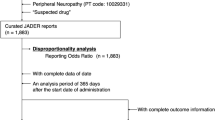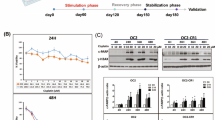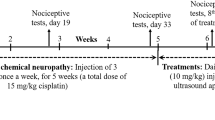Abstract
Previous work has shown platinum drugs to differ in their effects on the peripheral nervous system. To test whether their differential toxicity was due to differences in their partitioning into the peripheral nervous system, we correlated the hydrophobicity, reactivity, tissue accumulation and neurotoxicity of a series of eight platinum analogues. Neurotoxicity was detected by measuring sensory nerve conduction velocity (SNCV) in Wistar rats treated twice per week at the maximum tolerated dose. Tissue platinum concentrations were measured by inductively coupled plasma mass spectrometry. Hydrophobicity (log P) was measured using an octanol-aqueous shake-flask method. The half-life of platinum drug binding to plasma proteins in vitro was determined. The cumulative dose causing altered SNCV ranged from 15 to > 2050 μmol kg–1. Ranking of the compounds by their neurotoxic potency in rats (oxaliplatin >R,R -(DACH)PtC4> ormaplatin >S,S -(DACH)PtCl4>S,S -(DACH)Pt oxalato > cisplatin > carboplatin > JM216) correlated with the frequency of neurotoxicity in patients (r> 0.99;P< 0.05). Ranking the compounds by their peripheral nerve accumulation was cisplatin > carboplatin > oxaliplatin >R,R -(DACH)PtCl4≈S,S -(DACH)PtCl4and did not correlate with neurotoxicity. Log P ranged from – 2.53 to –0.16 but did not correlate with neurotoxicity. Log P correlated inversely with platinum accumulation in dorsal root ganglia (r2= 0.99;P = 0.04), sural nerve (r2= 0.85;P = 0.025), sciatic nerve (r2= 0.98;P = 0.0012), spinal cord (r2= 0.97, P = 0.018) and brain (r2= 0.98, P = 0.001). Reactivity correlated with neurotoxicity potency in rats (r2= 0.89, P = 0.0005) and with the frequency of neurotoxicity in patients (r2= 0.99, P = 0.0002). The hydrophilicity of platinum drugs correlates with platinum sequestration in the peripheral nervous system but not with neurotoxicity. Differences in the reactivity of platinum complexes accounts for some of the variation in their neurotoxicity. © 2000 Cancer Research Campaign
Similar content being viewed by others
Article PDF
Change history
16 November 2011
This paper was modified 12 months after initial publication to switch to Creative Commons licence terms, as noted at publication
References
Albert A (1979). Selective Toxicity: The Physiochemical Basis Of Therapy, Chapman and Hall: London
Borch RF (1987) The platinum anti-tumour drugs. Metabolism and Action of Anti-Cancer Drugs, Powis G, Prough R A (eds), pp. 163–193, Taylor and Francis: London
Braumann T (1986) Determination of hydrophobic parameters by reverse-phase liquid chromatography: theory, experimental techniques and applications in studies on quantitative structure-activity relationships. J Chromatogr 373: 191–225
Canetta R, Rozencweig MO and Carter SK (1985) Carboplatin: the clinical spectrum to date. Cancer Treat Rev 12 (Suppl A): 125–136
Dearden JC and Bresnen GM (1988) The measurement of partition coefficients. Quant Struct-act Rel 7: 133–144
Einhorn IH (1997) Testicular cancer: an oncological success story. Clin Cancer Res 3: 2630–2632
Gerritsen van der Hoop R, van der Burg Mel, Ten Bokkel Huinink WW, van Houwelingen JC and Neijt JP (1990) Incidence of neuropathy in 395 patients with ovarian cancer treated with or without cisplatin. Cancer 66: 1697–1702
Goyer RA (1996) Toxic effects of metals. Casarett and Doull's Toxicology: The Basic Science of Poisons, Klaassen CD (ed.) pp. 691–736, McGraw-Hill: New York
Gregg RW, Molepa JM, Monpetit VJA, Mikael NZ, Redmond D, Gadia M and Stewart DJ (1992) Cisplatin neurotoxicity: The relationship between dosage, time and platinum concentration in neurological tissues, and morphologic evidence of toxicity. J Clin Oncol 10: 795–803
Judson IR, Cerny T, Epelbaum R, Dunlop D, Smyth J, Schaefer B, Roelvink M, Kaplan S and Hanauske A (1997) Phase II trial of the oral platinum complex JM216 in non-small-cell lung cancer: an EORTC early clinical studies group investigation. Ann Oncol 8: 604–606
McGuire WP and Ozols RF (1998) Chemotherapy for advanced ovarian cancer. Semin Oncol 25: 340–348
McKeage MJ (1995) Comparative adverse effect profiles of platinum drugs. Drug Saf 13: 228–244
McKeage MJ, Boxall F, Jones M and Harrap KR (1994) Lack of neurotoxicity of oral bis-acetato-ammine-dichloro-cyclohexylamine-platinum(IV) (JM216) in comparison to cisplatin and tetraplatin in the rat. Cancer Res 54: 629–631
Machover D, Diaz-Rubio E, de Gramont A, Schilf A, Gastiaburu J, Brienza S, Itzhaki M, Metzger G, N’Daw D and Vignoud J (1996) Two consecutive phase II studies of oxaliplatin (l-OHP) for treatment of patients with advanced colorectal carcinoma who were resistant to previous treatment with fluoropyrimidines. Ann Oncol 7: 95–98
O’Rourke TJ, Weiss GR, New P, Burris HA, Rodriguez G, Eckhart J, Hardy J, Kuhn JG, Fields S and Clark GM (1998) Phase I clinical trial of ormaplatin (tetraplatin NSC 363812). Anticancer Drugs 5: 520–526
Schilder RJ, La Creta FP, Perez RP, Johnson SW, Brennan JM, Rogatko A, Nash S, McAleer C, Hamilton TC and Rody D (1994) Phase I and pharmacokinetic study of ormaplatin (tetraplatin, NSC 363812) administered on a day 1 and 8 schedule. Cancer Res 54: 709–717
Screnci D, Er HM, Hambley TH, Galettis P, Brouwer W and McKeage MJ (1997) Stereo-selective peripheral sensory neurotoxicity of diaminocyclohexane platinum enantiomers related to ormaplatin and oxaliplatin. Br J Cancer 76: 502–510
Screnci D, Galettis P, Baguley BC and McKeage MJ (1998) Optimization of an ICP-MS assay for the detection of trace levels of platinum in peripheral nerves. Atomic Spectrosc 19: 172–175
Thompson SW, Davis LE, Kornfeld M, Hilger RD and Standefer JC (1984) Cisplatin neurotoxicity: clinical, electrophysiologic, morphologic and toxicologic studies. Cancer 54: 1269–1275
van der Vijgh WJF and Klein I (1986) Protein binding of five platinum compounds: comparison of two ultrafiltration systems. Cancer Chemother Pharmacol 18: 129–132
Author information
Authors and Affiliations
Rights and permissions
From twelve months after its original publication, this work is licensed under the Creative Commons Attribution-NonCommercial-Share Alike 3.0 Unported License. To view a copy of this license, visit http://creativecommons.org/licenses/by-nc-sa/3.0/
About this article
Cite this article
Screnci, D., McKeage, M., Galettis, P. et al. Relationships between hydrophobicity, reactivity, accumulation and peripheral nerve toxicity of a series of platinum drugs. Br J Cancer 82, 966–972 (2000). https://doi.org/10.1054/bjoc.1999.1026
Received:
Revised:
Accepted:
Published:
Issue date:
DOI: https://doi.org/10.1054/bjoc.1999.1026
Keywords
This article is cited by
-
Butyl benzyl phthalate as a key component of phthalate ester in relation to cognitive impairment in NHANES elderly individuals and experimental mice
Environmental Science and Pollution Research (2023)
-
Magnetic Amine-Functionalized UiO-66 for Oxaliplatin Delivery to Colon Cancer Cells: In Vitro Studies
Journal of Cluster Science (2022)
-
Platinum accumulation in the brain and alteration in the central regulation of cardiovascular and respiratory functions in oxaliplatin-treated rats
Pflügers Archiv - European Journal of Physiology (2021)
-
Comparison of the Effect of Platinum (IV) Complexes on Spheroids and Monolayer Culture of HeLa Cells
Bulletin of Experimental Biology and Medicine (2020)
-
Identification of MRP2 as a targetable factor limiting oxaliplatin accumulation and response in gastrointestinal cancer
Scientific Reports (2019)



